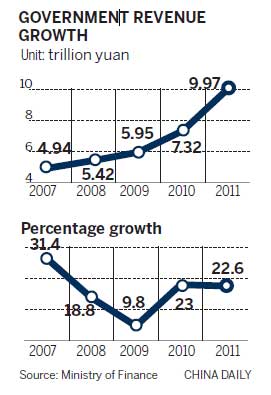New plan to reduce income inequality
Updated: 2012-05-23 02:32
By Lan Lan (China Daily)
|
|||||||||||
State Council set to approve move to narrow gap between rich and poor
A new income-distribution framework is set for approval to redress the growing gap between rich and poor, government officials said.
The framework comes at a time when the most affluent 10 percent of the population make 23 times more than the poorest 10 percent.
In 1988 it was seven times.
The framework, eight years in the making, has been tabled for approval by the State Council and is likely to be introduced in the second half of this year.
"If low-income families cannot afford a decent standard of living, rich families will not enjoy any sense of security. That is a problem for the world, not just China," Yang Yiyong, director of the Social Development Research Institute under the National Development and Reform Commission, said in an interview with China Daily.
|
|
Tax revenue grew from 7.3 trillion yuan ($1.12 trillion) in 2010 to nearly 9 trillion yuan in 2011, a 22.6 percent increase. It greatly outpaced urban income growth, 8.4 percent, and rural income growth, 11.4 percent.
Per capita income in China has just exceeded $4,000.
As part of income-distribution reform, government agencies, at both central and local levels, will be urged to pass legislation to cut taxes and regulate executive pay in high-profit monopoly industries and private companies, Yang said.
The framework will see an enlarged middle-income group and high earners will pay more in tax.
It is time for common prosperity, Yang declared, although one government plan is not going to provide all the answers to the thorny issue of income distribution in a society of 1.3 billion people.
This is not just about individual tastes or lifestyle, economists point out. It reflects a yawning gap between rich and poor that is hindering the world's second-largest economy from making further progress and perhaps eroding its very social fabric, Yang said.
Gini coefficient
The framework may use the Gini coefficient, an internationally accepted gauge of income inequality, or adopt a mix of indicators, such as urban-rural income disparity or wage differences among various industries.
Targets would almost certainly be more powerful than persuasion, he said.
The country’s Gini coefficient has already reached a high, if not dangerous level. It is close to 0.5, he said, a point that "is threatening" social security. Little room is left for the index to grow.
The last time the government reported the Gini coefficient was in 2000, when it stood at 0.412.
The National Bureau of Statistics said 2011’s Gini coefficient was "a little higher than 2010," without specifying either number. In January, the NBS said the main reason that China did not release the figure because data about high-income groups was still incomplete.
Today's Top News
President Xi confident in recovery from quake
H7N9 update: 104 cases, 21 deaths
Telecom workers restore links
Coal mine blast kills 18 in Jilin
Intl scholarship puts China on the map
More bird flu patients discharged
Gold loses sheen, but still a safe bet
US 'turns blind eye to human rights'
Hot Topics
Lunar probe , China growth forecasts, Emission rules get tougher, China seen through 'colored lens', International board,
Editor's Picks

|

|

|

|

|

|






